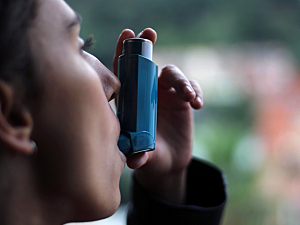Aspirin-exacerbated respiratory disease (AERD) was defined in the 1960s as Samter’s triad: asthma, chronic rhinosinusitis with nasal polyposis, and hypersensitivity to aspirin (now known to extend to newer nonselective nonsteroidal anti-inflammatory drugs). Decades later, though, there’s still little known about how these three diagnoses interrelate.
Using prospectively collected registry data, researchers at Brigham and Women’s Hospital linked increased severity of sinonasal symptoms in patients with AERD to both worse patient-reported asthma control and worse objectively measured lung function.
Regan W. Bergmark, MD, a sinus and endoscopic skull base surgeon in the Division of Otolaryngology–Head and Neck Surgery at the Brigham, Tanya M. Laidlaw, MD, director of translational research in the Division of Allergy and Clinical Immunology, and colleagues published the findings in The Journal of Allergy and Clinical Immunology: In Practice.
Methods
All 1,065 patients enrolled in the AERD registry at the Brigham between 2013 and 2018 were included in this study. At the time of enrollment and at all subsequent visits, they completed the Asthma Control Test (ACT) and the 22-item Sino-Nasal Outcome Test (SNOT-22).
To determine associations between diagnoses, the researchers evaluated:
- 1,185 pairings of ACT and SNOT-22 scores from 845 subjects
- 485 pairings of SNOT-22 scores and FEV1% predicted measurements from 246 subjects
- 616 pairings of ACT scores and FEV1% predicted measurements from 269 subjects
Asthma Symptomatology
The mean ACT score at enrollment was 18.77, which represents not well-controlled asthma (intermediate between well-controlled and uncontrolled).
Sinonasal Symptomatology
At enrollment, the five individual symptoms rated as most severe on the SNOT-22 were all sinonasal:
- Loss of sense of smell/taste—mean score 3.73 out of 5
- Nasal blockage/congestion—3.28
- Need to blow nose—2.99
- Postnasal drip—2.90
- Thick nasal discharge—2.87
The three next most severe symptoms were related to daytime fatigue/lack of restorative sleep (mean scores of 2.77–2.54). Facial pain/pressure was less severe (mean score 1.84).
The mean score for the SNOT-22 sinonasal domain was 22 (55% of the maximum score of 40). The corresponding figures for the sleep domain were 19 (47% of the maximum score).
Interrelationships
- A 10-point increase in SNOT-22 total score was significantly associated with a 0.87-unit decrease in ACT score (P<0.0001)
- A 10-point increase in SNOT-22 total score was significantly associated with a 0.75-point decrease in FEV1% predicted (P=0.0182)
- A 1-unit increase in ACT score was significantly associated with a 1-point increase in FEV1% predicted (P<0.0001)
The relationships remained robust in a multivariable-adjusted model, with the effect sizes actually increasing slightly.
Takeaway Messages
Key conclusions from this study are:
- Patients with AERD have an extremely high burden of sinonasal and asthma symptoms
- Patients with AERD who report worsening sinonasal symptoms should be evaluated for asthma control and pulmonary function
- The combination of smell/taste loss and nasal obstruction with limited or no facial pain should prompt clinicians to consider a diagnosis of AERD in a patient not yet diagnosed with that condition
The researchers plan future work to examine whether aggressive control of sinonasal disease reduces asthma severity.
